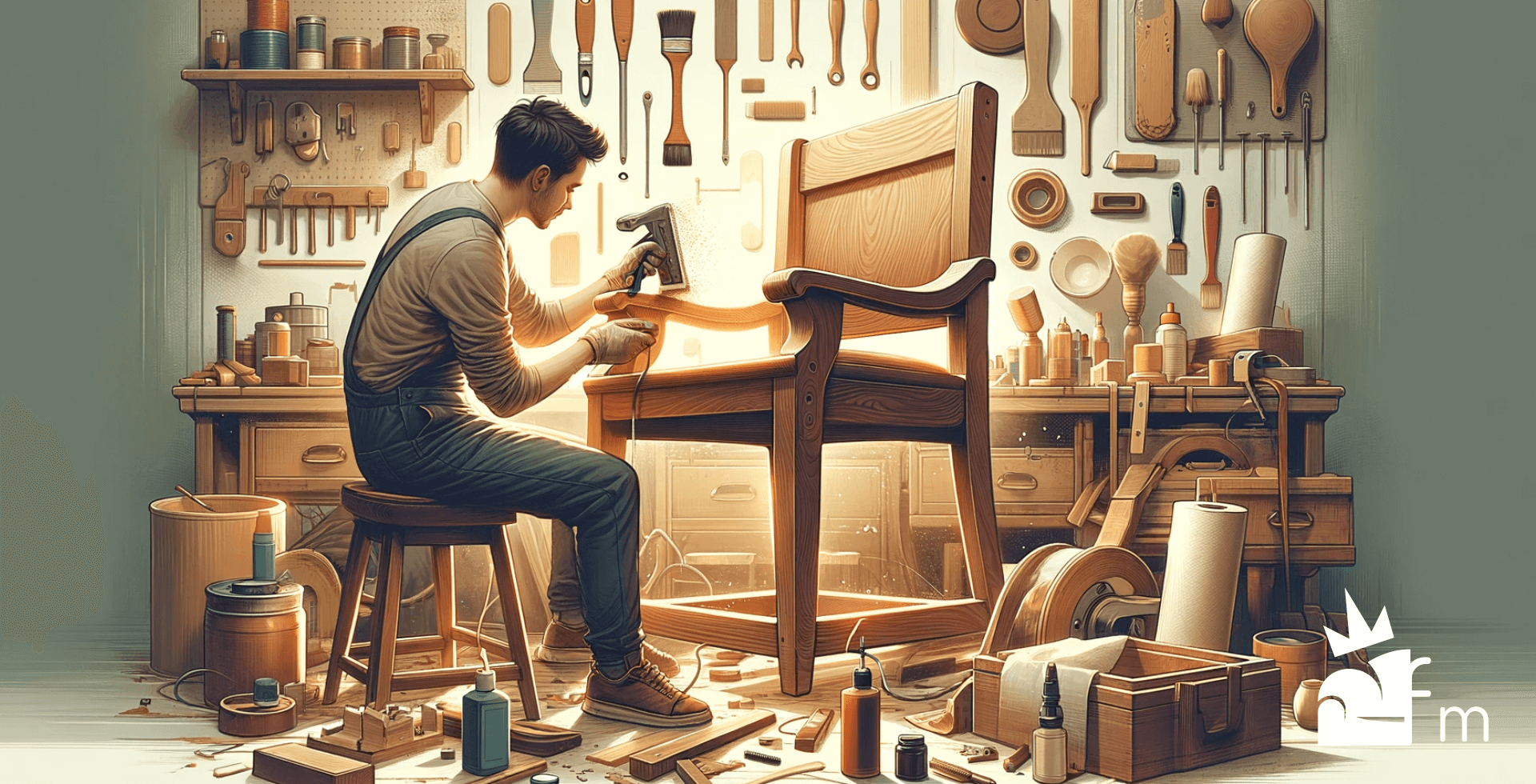Your furniture adds an extra layer of beauty around your home environment, making it more attractive for visitors. But, how to fix damaged wood furniture when it gets get wrecked in a spot? Don’t be startled, it’s not that hard to fix damaged wood furniture like the steel ones.
You might face different kinds of damage proportions that require multiple fixing techniques. You will require some necessary tools too for the process, overall it’s time consuming work finish.
In this tutorial, we will show you some great ways to repair different types of damage on wood furniture step by step.
Let’s get started,
- How to Fix Damaged Wood Furniture Against Different Types of Ravage?
- Necessary Tools and Materials for the Work
- Step-by-Step Repair Guides for 4 Types of Furniture Damage
- FAQ
- Final Verdict
How to Fix Damaged Wood Furniture Against Different Types of Ravage?

Before the process starts, you have to know what type of damage you are dealing with. There are 4 major types of wood furniture damage that you will see.
1. Scratches
Scratches are more than mere linear marks; they are disruptions that mar the aesthetics of your wood furniture. The scratches can be shallow surface lines that are hardly noticeable, or they can be deep grooves that capture attention. Sometimes, these are the result of everyday activities, such as dragging a plate across a wooden dining table or letting a pet jump on a wooden surface. In other cases, they can happen when you’re moving furniture and the piece rubs against a wall or the floor.
2. Dents
Dents can differ in size and depth but are generally characterized by their indentation into the wood. They can be small and barely perceptible or large and glaringly obvious. The impact that causes a dent can range from something as simple as accidentally knocking over a book onto a wooden surface to something more forceful, like hitting the furniture with a heavy object during a move. Dents are particularly noticeable on polished or finely finished surfaces where they break the uniformity of the wood.
3. Watermarks
Watermarks are often more complicated than just discolored patches; they can affect the texture of the wood as well. Watermarks can appear as a lightening or darkening of the wood, sometimes accompanied by a raised grain.
They occur when moisture infiltrates the wood fibers, leading to discoloration. Common examples include leaving a sweating glass on a wooden coffee table or placing a hot dish directly on a wooden surface without any protective layer. Over time, this moisture penetration may also weaken the wood, making it more susceptible to other forms of damage. This problem also occurs with the clean white couches!
4. Chipped wood
Chipped wood is usually characterized by small or large pieces of wood that have broken off, leaving an unsightly and often sharp edge. Unlike scratches or dents, chipped wood often involves the removal of a piece of the material, which makes it more challenging to repair.
Chipped wood can occur when a piece of furniture is dropped during moving, or if it’s scraped against a hard surface, like a wall or a door frame. In some instances, wood can also chip if it has become weakened over time, and a small amount of force is applied.
Necessary Tools and Materials for the Work
If you see the damage is little, then consider using only the tools you have in your house for the repair. For advanced repairs, you will require more tools. Here is a list of things you will need,
Basic hand tools
- Screwdriver: For tightening or removing screws.
- Hammer: To fix loose nails or help with disassembly.
- Pliers: For removing nails or staples.
- Utility Knife: For precise cutting tasks.
- Chisel: For removing larger pieces of damaged wood.
- Measuring Tape: To accurately measure areas that need repair.
- Putty Knife: To apply and spread wood filler.
- Clamps: To hold glued pieces together while drying.
Finishing and safety materials
- Sandpaper: To smooth out rough surfaces and prepare wood for painting or staining.
- Wood Filler: To fill in holes, dents, or chipped wood.
- Wood Glue: To bond broken or loose parts together.
- Paint or Stain: For finishing and color matching.
- Paint Brushes: To apply paint or stain.
- Tack Cloth: For removing dust after sanding.
- Rags or Clothes: For cleaning and applying stain.
- Varnish or Clear Coat: To protect the finished wood.
- Safety Gear (Gloves, Goggles, Mask): For personal protection during the process.
Step-by-Step Repair Guides for 4 Types of Furniture Damage
Below, we will guide you through 4 types of repair for wooden furniture. All these procedures are recommended by professionals in these fields.
1. How to fix scratches on a furniture
Step 1: Assess the scratch
First, determine the depth and length of the scratch. This will help you decide what materials you’ll need and how much work is involved.
Step 2: Sand the area
Use fine-grit sandpaper to gently sand the scratched area. Make sure to sand along the grain of the wood to avoid further damage. This will help prepare the surface for filling.
Step 3: Fill It In
Choose a wood filler that matches the color of your furniture. Use a putty knife to apply the filler into the scratch. Smooth it out so it’s level with the surrounding wood.
Step 4: Finish with paint or varnish
After the filler has dried, lightly sand the area once more to ensure smoothness. Then, apply paint or varnish that matches your furniture’s existing finish. Allow it to dry completely.
2. How to fix dents
Step 1: Wet the dented area
Dampen a cloth with water and apply it to the dented area. The goal is to introduce moisture into the fibers of the wood, making it more pliable for repair.
Step 2: Use a heat source
Place a cloth over the wet, dented area to act as a barrier. Then, use an iron on a low setting to apply heat through the cloth. This will help the wood fibers swell and potentially lift the dent. Keep the iron moving to avoid scorching the wood.
Step 3: Sand and finish
After the area has cooled and dried, assess the dent. If it has lifted sufficiently, proceed to sand the area lightly to smooth out any raised grain or residual moisture marks. Finish by applying a matching paint or varnish to the sanded area.
3. How to remove watermarks
Step 1: Use a cloth and iron
First, place a clean, white cloth over the area with the watermark. With your iron set to a low heat setting, gently iron over the cloth. Be sure to keep the iron moving to avoid scorching. This will help lift the moisture from the wood.
Step 2: Apply a specialized remover
If the watermark remains, it’s time to apply a specialized watermark remover. Use a cloth to gently apply the remover onto the affected area, working in the direction of the wood grain.
Step 3: Sand and finish
Still see the watermark? You’ll need to sand the area. Use fine-grit sandpaper to lightly sand away the watermark. After sanding, apply a coat of paint or varnish that matches your furniture’s existing finish.
4. How to repair chipped wood
Step 1: Remove loose wood
First, identify the chipped area and carefully remove any loose or splintered wood using a putty knife or a chisel. Make sure to only remove the wood that’s already loose to avoid further damage.
Step 2: Apply wood filler
Next, take a wood filler that closely matches your furniture’s color and apply it to the chipped area. Use a putty knife to smooth the filler and make it level with the surrounding wood surface.
Step 3: Sand and finish
Once the wood filler has completely dried, use fine-grit sandpaper to smooth out the area. Make sure the filler blends seamlessly with the rest of the furniture. Finally, apply a matching coat of paint or varnish to finish the repair.
FAQ
Can you fix fake wood furniture?
Absolutely, fake wood furniture, typically made from laminate or veneer, can be repaired, though the process varies from natural wood repair. Utilize fillers, adhesives, or paints that are specifically designed for these materials. If you’re dealing with chipped corners or peeling layers, using a strong adhesive can help reattach the pieces. Specialized paints and primers are also available for these surfaces, making it possible to not just repair but also redecorate your fake wood furniture effectively.
How to scrap furniture finish?
Stripping the finish off furniture is an essential part of many restoration projects. Chemical strippers are often the go-to choice for quick and efficient removal. However, they require good ventilation and protective gear.
Alternatively, sanding can be employed for a more controlled, though labor-intensive, approach. Starting with a test area is crucial, as it helps you gauge the responsiveness of the finish to the chosen removal method, and lets you adjust your approach accordingly.
Should you paint wood without sanding?
While it might be tempting to save time by skipping the sanding process, it’s generally not advisable. Sanding prepares the wood surface for painting by improving adhesion, and it ensures a smoother, more even finish. Without sanding, you run the risk of uneven paint application and reduced durability. Some specialty paints claim to adhere well without sanding, but for a truly professional finish, sanding is usually recommended.
How to save damaged wood?
If you’re looking to salvage damaged wood, the first step is to carefully assess the extent of the damage. Loose or rotted sections should be removed immediately to prevent further deterioration. High-quality wood fillers can then be applied to fill in gaps or holes.
After the filler has dried, the area should be sanded down to ensure it is flush with the surrounding wood. A finishing coat of paint or varnish can then be applied to seal the wood and prevent future damage.
Should you use coconut oil on wood?
Coconut oil can provide a quick, natural shine to wood surfaces, but it’s generally not the best option for long-term wood maintenance. Coconut oil doesn’t provide the same level of protection as traditional wood oils or sealants, which are specifically designed to penetrate deep into the wood and offer better durability and protection against moisture and wear.
Final Verdict
To preserve the life and aesthetics of your wooden furniture, understanding various types of damage is invaluable. Whether you’re dealing with scratches, dents, watermarks, or chipped wood, each issue requires a specific approach, skill set, and toolkit. But what truly stands out is your ability to breathe new life into pieces that many would deem beyond repair, adding not just to your home’s decor but also to its character and story.
So, how to fix damaged wood furniture? It depends on your efforts in restoring damaged wooden furniture not only contribute to environmental sustainability but also epitomize the love for craftsmanship. When you invest time and resources into fixing these imperfections, you’re doing more than simple repair work; you’re participating in the age-old tradition of cherishing and preserving woodwork.
We would be glad if this guide provided crucial information to fix your wooden furniture in any sort.
Have a wonderful day!

